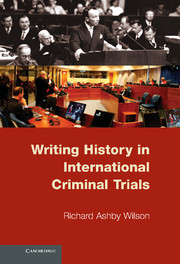Book contents
- Frontmatter
- Contents
- Epigraph
- Preface and Acknowledgments
- Figures and Tables
- Glossary
- 1 Assessing Court Histories of Mass Crimes
- 2 What Does International Actually Mean for International Criminal Trials?
- 3 Contrasting Evidence: International and Common Law Approaches to Expert Testimony
- 4 Does History Have Any Legal Relevance in International Criminal Trials?
- 5 From Monumental History to Microhistories
- 6 Exoneration and Mitigation in Defense Histories
- 7 Misjudging Rwandan Society and History at the International Criminal Tribunal for Rwanda
- 8 Permanent Justice: The International Criminal Court
- 9 Conclusion: New Directions in International Criminal Trials
- Appendix: Methodology and the Survey Instrument
- Bibliography
- Index
Appendix: Methodology and the Survey Instrument
Published online by Cambridge University Press: 05 June 2012
- Frontmatter
- Contents
- Epigraph
- Preface and Acknowledgments
- Figures and Tables
- Glossary
- 1 Assessing Court Histories of Mass Crimes
- 2 What Does International Actually Mean for International Criminal Trials?
- 3 Contrasting Evidence: International and Common Law Approaches to Expert Testimony
- 4 Does History Have Any Legal Relevance in International Criminal Trials?
- 5 From Monumental History to Microhistories
- 6 Exoneration and Mitigation in Defense Histories
- 7 Misjudging Rwandan Society and History at the International Criminal Tribunal for Rwanda
- 8 Permanent Justice: The International Criminal Court
- 9 Conclusion: New Directions in International Criminal Trials
- Appendix: Methodology and the Survey Instrument
- Bibliography
- Index
Summary
The survey instrument was developed in early 2009 by Andrew Corin, Ahmad Wais Wardak, and Richard Ashby Wilson, and a preliminary version was reviewed by the assistant director of the Center for Survey Research and Analysis at the University of Connecticut. The modified version was tested on a focus group of six individuals who were former ICTY staff members and consultant expert witnesses who had not been included in the survey. Participants in the focus group encouraged us to better define some of the terms being used, especially “historian” and “historical evidence.” We included a fuller definition in the survey preamble and on the Internet page linked to the survey, which explained the rationale for the research project.
The questions that constituted the final survey instrument were divided into two parts. Part 1 elicited information about the background of respondents, including the organ of the ICTY (including defense) with which the respondent was last associated, the form and length of the respondent's participation in the work of the ICTY, the nature of the respondent's professional activities at the time when he or she first became associated with the ICTY, and the respondent's familiarity with the former Yugoslavia and criminal justice systems before his or her association with the Tribunal. Part 2 elicited responses on the substantive issues addressed by the survey. The survey comprised twenty-two numbered questions, although some of these were multiple related questions, thus, the number of questions to which a respondent could reply was in fact thirty-six.
- Type
- Chapter
- Information
- Writing History in International Criminal Trials , pp. 227 - 230Publisher: Cambridge University PressPrint publication year: 2011



